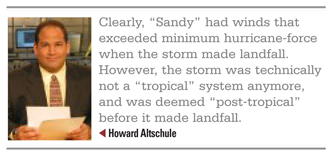(Editor's Note: This story has been contributed by Howard Altschule, a forensic meteorologist who has appeared on The Today Show and Court TV, as well as The Weather Channel and The New York Times.)
According to NBC News, Gov. Andrew Cuomo stated that New York homeowners will not have to pay “hurricane deductibles” on insurance claims stemming from Hurricane Sandy. Superintendent of Financial Services Benjamin Lawsky said the state told the insurance industry that deductibles weren't triggered because Sandy did not sustain hurricane-force winds when it hit New York. As a veteran forensic meteorologist, I have worked on numerous hurricane-related lawsuits and insurance claims of this sort, whether the weather system was a “named storm” or not. 
In the past, terms like “hurricane-force,” “tropical storm,” and even “remnants of Hurricane X” have often been significant issues and arguable topics when it comes to litigations or determining insurance coverage from claims that arise. In the case of “Sandy,” it appears that this could be the case as well.
Recommended For You
Want to continue reading?
Become a Free PropertyCasualty360 Digital Reader
Your access to unlimited PropertyCasualty360 content isn’t changing.
Once you are an ALM digital member, you’ll receive:
- Breaking insurance news and analysis, on-site and via our newsletters and custom alerts
- Weekly Insurance Speak podcast featuring exclusive interviews with industry leaders
- Educational webcasts, white papers, and ebooks from industry thought leaders
- Critical converage of the employee benefits and financial advisory markets on our other ALM sites, BenefitsPRO and ThinkAdvisor
Already have an account? Sign In Now
© 2025 ALM Global, LLC, All Rights Reserved. Request academic re-use from www.copyright.com. All other uses, submit a request to [email protected]. For more information visit Asset & Logo Licensing.








